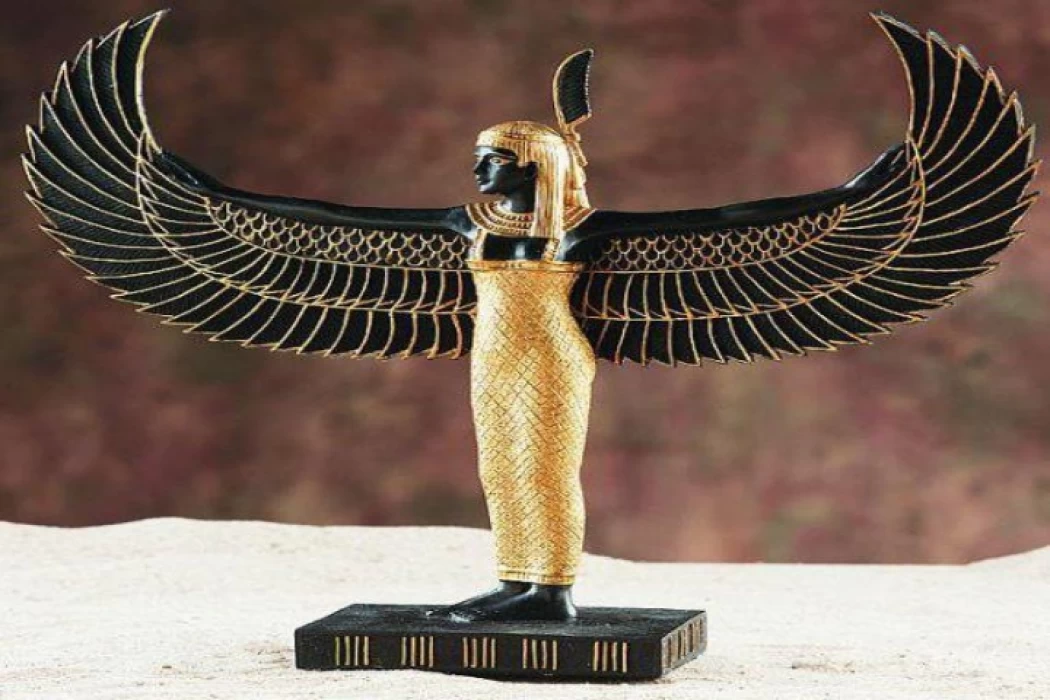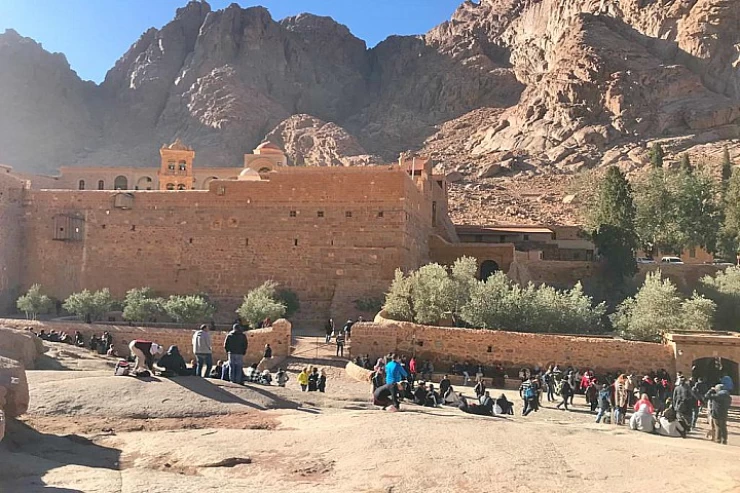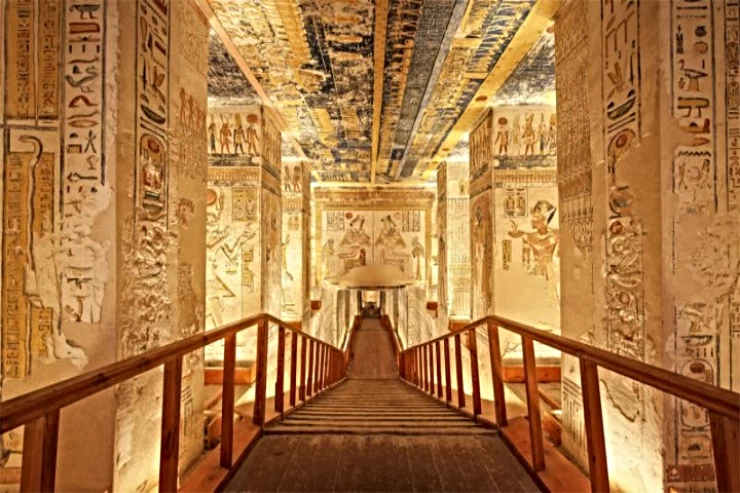
Ma`at Goddess in Ancient Egypt
Ma`at Goddess in Ancient Egypt
Goddess Ma`at according to ancient Egyptian religion is a goddess of truth and justice, Ma`at is the daughter of Re god and wife to Thout god of knowledge Ma`at goddess represented in women form with ostrich feather above her head and holding the Ankh which means the life key and the other hand holding the mace
In the underworld of the ancient Egyptians, the heart of the dead were placed on the scales on one side and the feather of the goddess Maat on the other side. If the deceased’s heart tilted, he would enter Paradise in their beliefs, but if the feather swelled, he would enter Hell, which was represented by ancient Egyptian beliefs in the form of an imaginary predatory monster named Amamut, whose head is the head of a crocodile and his body is the body of a lion and its back is the body of a hippo. The court in the underworld consisted of 42 judges, the number of regions of Egypt, headed by Osiris.
The conception of the ancient Egyptians on Judgment Day was that Anubis would accompany the dead to the courtroom, and judges would begin to question the deceased about his actions in this world, and whether he was following the Maat (the right path) or was he among the sinners. And the deceased begins to defend himself and says: I did not kill anyone, I did not expose a person, and I did not complain about a worker with his boss, and I did not steal. And I was feeding the poor, and I was given clothes to the naked, and I helped people, and I used to give the thirsty water. Then the judges began to ask him about his knowledge of the gods, so he had to mention the gods by their names and beware of forgetting one of them.
The (Maat) offering is one of the most important and most important types of offerings that the kings were keen to depict in temples because of its significance and great importance. The sacrifice of “Maat” confirms the king’s mission to achieve order (Maat) on earth and to satisfy the gods. [4]
The concept of "Maat" was the exact standard system for everything, which represents the basis of the world, and everything that corresponds to the purposes of the Creator deity. Hence, it is imperative for humans to preserve and approve them, and to restore "Maat" and the system to its proper condition if it is exposed to any defect or disorder. And since the Egyptian view of the maat as the essence and material element upon which the whole world lives, and as a power for gods and for the living and the dead among humans, the "Coffins Texts" mentioned that gods live on (Maat), and the gods approved "Maat" on earth, and its approval was on The land is the responsibility of the king, who represents the gods among men, and lives like it on (Maat).
The offering of "Maat" summarizes in a strong symbolic form all that is meant by worship and sacrifices offered to the gods, and all the rituals of the daily service in the temples, and the offerings offered. Therefore, an Egyptian temple is almost not devoid of the scene of the sacrifice of the "Maat" in the various inscriptions, religious scenes, and scenes of the offering and rituals.
It was necessary for the king to acknowledge the “Maat” on earth, and this was embodied in the King’s presentation of the offering of “Maat” to the gods as a metaphor for establishing order and justice, and whatever the gods wanted. The king used to present it daily to the gods as tangible proof of his being a representative for them in his divine office in the framework of (Maat).
The “sacrifice of maat” indicates that the king’s mission is to achieve the “maat,” meaning that the sacrifice here is a metaphor or a symbolic expression to complete the task the king is responsible for. Although many texts indicate that both the gods and the king revive the "Maat" in the moral sense more than in the sacrificial sense and that the deity and the king only feed on the "Maat" as the truth that is said, and the justice that is established.
The sacrifice of Maat appeared in the Middle Kingdom, although it did not appear after that until the reign of King Thutmose III. The scene (the offering of the “Maat”) was recorded in the inscriptions of the walls of most Egyptian temples, and in it the king is shown standing in front of the deity and presented to him the symbol of “Maat” in his hand, or on a vessel. And the sacrifice of "Maat" will be in the form of a small statue of the goddess "Maat", the goddess of truth, justice, and the tight cosmic order seated with a feather of "Maat" on her head, and in her hand is the sign of life. In rare cases, we find the presentation of the "Maat" feather only, and that was in the temple of "Seboua" to King "Ramses the Second".
Among the temples in which the scene of the sacrifice of "Maat" appeared: the "Amun-Ra" temple at Karnak (in a number of scenes from the reign of King "Thutmose III", in front of a number of deities); And the "Aton" temple in "Karnak"; And the Temple of "Seti the First" in Abydos, and the Temple of "Luxor". Usually, the inscription is accompanied by the form of offering, which includes the phrase: “Hnk mAat n nb MAat” (offering Maat to the Lord of Maat). Usually, the (Maat sacrifice) was presented to male gods and not to females. And in the forefront of the gods who were depicted receiving the sacrifice: (Amun; Amun-Ra; Hor-Akhati; Amun-Ra Ka-Mutaf; Amun Min; Ra-Hor Akhti; Ptah; Khonsu; Shu; Ozir; Set; Atum; Montu; Khnum; Sobek; Hathor, Iza, Min).
Ma`at Goddess in Ancient Egypt
Goddess Ma`at according to ancient Egyptian religion is a goddess of truth and justice, Ma`at is the daughter of Re god and wife to Thout god of knowledge Ma`at goddess represented in women form with ostrich feather above her head and holding the Ankh which means the life key and the other hand holding the mace
In the underworld of the ancient Egyptians, the heart of the dead were placed on the scales on one side and the feather of the goddess Maat on the other side. If the deceased’s heart tilted, he would enter Paradise in their beliefs, but if the feather swelled, he would enter Hell, which was represented by ancient Egyptian beliefs in the form of an imaginary predatory monster named Amamut, whose head is the head of a crocodile and his body is the body of a lion and its back is the body of a hippo. The court in the underworld consisted of 42 judges, the number of regions of Egypt, headed by Osiris.
The 42 Laws of Maat: Ancient Egyptian Society's Ethical Underpinnings The fundamental tenets of justice and morality in ancient Egypt were established by the 42 Laws of Maat.
The conception of the ancient Egyptians on Judgment Day was that Anubis would accompany the dead to the courtroom, and judges would begin to question the deceased about his actions in this world, and whether he was following the Maat (the right path) or was he among the sinners. And the deceased begins to defend himself and says: I did not kill anyone, I did not expose a person, and I did not complain about a worker with his boss, and I did not steal. I was feeding the poor, and I was given clothes to the naked, and I helped people, and I used to give the thirsty water. Then the judges began to ask him about his knowledge of the gods, so he had to mention the gods by their names and beware of forgetting one of them.
To the pharaohs, Ma'at was represented as a goddess with an ostrich feather on her head, a symbol of justice. The goddess held the key of life, Menkh, in one hand and a scepter in the other, symbolizing balance. She was credited with controlling the seasons and the movements of the planets and stars.
The Cult of Maat
While the cult of Maat was more than limited, the respect she commanded was, however, boundless. For maat (justice) was always a cornerstone of social balance. Respect among humankind, in particular, ensured a measure of salvation. A salvation that Maat would appreciate during the final judgment rendered by Osiris. "To speak according to Maat" meant to speak the truth. At the Last Judgment, the heart spoke according to Maat and could not lie. Upon death, no deceased could avoid the trial of the Last Judgment.
There, the weight of good and evil accumulated in each person's heart was calculated. Thus, the deceased who had lived with justice and kindness would be assured of having their heart compared to Maat, to their advantage. It was during psychostasis (the "weighing of the soul") that everything concerning their future in the afterlife was decided. Maat as a principle was created to meet the complex needs of the emerging Egyptian state, which embraced diverse peoples with conflicting interests. The development of such rules sought to avoid chaos, and Maat became the basis of Egyptian legislation.
The concept of "Maat" was the exact standard system for everything, which represents the basis of the world, and everything that corresponds to the purposes of the Creator deity. Hence, it is imperative for humans to preserve and approve them, and to restore "Maat" and the system to its proper condition if it is exposed to any defect or disorder.
And since the Egyptian view of the maat as the essence and material element upon which the whole world lives, and as a power for gods and for the living and the dead among humans, the "Coffins Texts" mentioned that gods live on (Maat), and the gods approved "Maat" on earth, and its approval was on The land is the responsibility of the king, who represents the gods among men, and lives like it on (Maat).
















